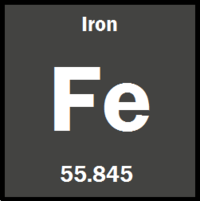Iron
Iron (Fe) is the 26th element on the periodic table and has been used by humans for over 5000 years.[1] It is one of the most abundant metals on Earth, making up 5.6% of the Earth's crust and nearly all of the Earth's core.
Some useful properties of iron include:[1]
| Atomic weight | 55.845 |
| Density (at 0oC) | 7.874 g/cm3 |
| Boiling point | 3134 K |
| Melting point | 1811 K |
| Embodied energy[2] | 20-25 MJ/kg |
Iron has played a key role in humanity's history, as those who could manipulate it to craft weapons, tools, and other materials gained economic and political power.[3] In modern society iron is the most important of all metals, as it is used to craft different types of steel which is used in a diverse array of applications. Steel is used to make paperclips, skyscrapers, and everything in between.[1]
Iron is also an important element in plant and animal life. In plants it plays a role in the creation of chlorophyll, and in humans it plays a crucial role in the vascular system.
Energy use of iron in society

Iron makes up 95% of all metal tonnage produced worldwide, with over 500 million tonnes of new iron and 300 million tonnes of recycled iron being output each year.[5] This output of iron is possible due to the enormous reserves of iron on Earth, exceeding 100 billion tonnes. Most mining occurs in China, Brazil, Australia, Russia, and the Ukraine.
Around 18% of the world's industrial energy use goes into the mining, processing and manufacturing of iron and steel products.[6] In terms of the actual energy, it uses about 19 of the 106 exajoules (1019 joules) input into the industrial sector each year.
Iron has an embodied energy of 20-25 megajoules per kilogram (MJ/kg),[2] which is the energy required to extract, refine, and process it. This puts the yearly energy use of attaining iron in the ballpark of 10 exajoules.
To learn more about what happens to iron once it is mined, see: Steel
Magnetic properties
Iron is one of the few elements that exhibits ferromagnetism. Iron's molecular structure is such that there exist domains of electrons that line up their spins, resulting in highly localized magnetic fields. These domains are often randomly oriented however, so the bulk material displays no magnetic properties. The interesting characteristic of the material occurs when an external magnetic field is applied to the iron, causing these domains to line up with one another, and the material is said to be magnetized.[7]
Ferromagnetic materials such as iron are highly useful in everyday life, as well as in specialized applications. Common uses include electric motors, generators, transformers, telephones, and speakers.[8]
Nuclear stability
The iron group (from chromium to nickel) contains the most stable isotopes of all elements, having the highest binding energy per nucleon.[9] The significance of this is critical to the abundances of these metals in the universe, as well as the production of all heavier elements which are created from supernovae. Nuclear fusion in heavy stars is halted by these stable elements, since the fusion process can no longer exert any more energy, causing stellar collapse and triggering supernovae.[10]
Video
The video below is from the University of Nottingham's periodic videos project.[11] They have created a complete suite of short videos on every element on the periodic table of elements.
References
- ↑ 1.0 1.1 1.2 1.3 Jefferson Labs. (Accessed February 17, 2016). The Element Iron [online], Available: http://education.jlab.org/itselemental/ele026.html
- ↑ 2.0 2.1 UNEP. (August 19, 2015). Environmental Risks and Challenges of Anthropogenic Metals Flows and Cycles [Online]. Available: https://d396qusza40orc.cloudfront.net/metals/3_Environmental_Challenges_Metals-Full%20Report_36dpi_130923.pdf#96
- ↑ Royal Society of Chemistry. (Accessed February 17, 2016) [Online], Available: http://www.rsc.org/periodic-table/element/26/iron
- ↑ Wikimedia Commons [Online], Available: https://commons.wikimedia.org/wiki/File:US_Navy_060616-N-9712C-009_Steelworker_3rd_Class_Robert_Sprague_ties_together_rebar_before_a_concrete_placement_on_a_bridge_project.jpg
- ↑ Lenntech. (Accessed February 17, 2016). Iron (Fe) [Online], Available: http://www.lenntech.com/periodic/elements/fe.htm
- ↑ IEA (2014), "World energy balances", IEA World Energy Statistics and Balances (database). DOI: http://dx.doi.org/10.1787/data-00512-en (Accessed February 2015)
- ↑ Hyperphysics. (Accessed March 12, 2016). Ferromagnetism [Online], Available: http://hyperphysics.phy-astr.gsu.edu/hbase/solids/ferro.html
- ↑ Encyclopaedia Brittanica. (Accessed March 12, 2016). ferromagnetism [Online], Available: http://www.britannica.com/science/ferromagnetism
- ↑ Hyperphysics. (Accessed March 12, 2016). The Most Tightly Bound Nuclei [Online], Available: http://hyperphysics.phy-astr.gsu.edu/hbase/nucene/nucbin2.html
- ↑ Hyperphyics. (Accessed March 12, 2016). Nuclear synthesis [Online], Available: http://hyperphysics.phy-astr.gsu.edu/hbase/astro/nucsyn.html#c1
- ↑ See more videos from the University of Nottingham on different elements here: http://www.periodicvideos.com/


